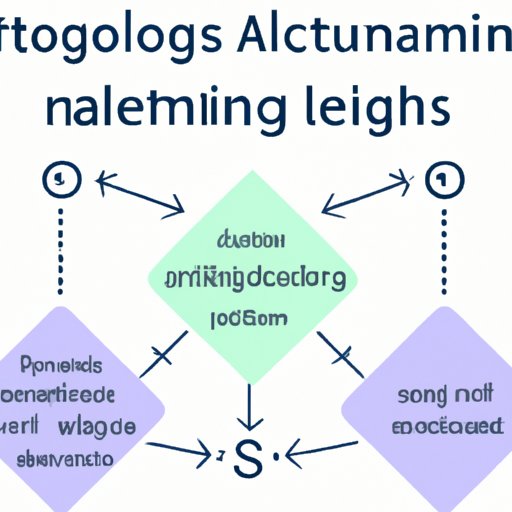Introduction
Have you ever wondered how your computer is able to perform complex tasks like generating search results within moments? Or how self-driving cars are able to identify obstacles and make decisions in real-time? The answer lies in algorithms. In this article, we will explore what algorithms are, their components, execution, and importance in computer science and problem-solving.
Defining Algorithms: The Ultimate Guide for Beginners in Computer Science
An algorithm is a step-by-step procedure that outlines how to solve a problem. In computer science, algorithms are a specific set of instructions that define how a computer program should work. They are crucial in developing software and improving system performance. Algorithms aid problem-solving by breaking complex problems down into smaller, more manageable components, enabling systematic solutions to larger problems.
One simple example of an algorithm in everyday life is the recipe for making pancakes. It requires a specific set of instructions that outlines the ingredients and procedure for mixing and cooking the pancakes. Another instance is the formula used to calculate average scores in school exams. These examples illustrate the use of algorithms outside of computer science and how they aid daily problem-solving.

Algorithms: A Computer Science Concept Made Simple
An algorithm typically consists of five components:
- Input – the initial data that are fed to the algorithm
- Output – the result generated by the algorithm after processing the input
- Unambiguous – each step in the algorithm is clear and precise
- Terminating – the algorithm reaches an endpoint after completing all steps
- Iterative – the algorithm repeats a set of instructions until a specific condition is met.
When an algorithm is executed, it follows the set of instructions sequentially until it reaches the final output. Simple algorithms include finding the sum of two numbers, comparing the size of two lists and determining the larger one, and reversing a string.

How to Teach Algorithms to Someone Who Has No Programming Background
Teaching algorithms to individuals with no programming background can be a challenge. Visual aids, practical examples, and concise definitions are essential. Use visual aids such as flowcharts and diagrams to display how the algorithm works. Emphasize practical examples, such as sorting laundry or building a set of Lego blocks. Provide real-life scenarios to demonstrate the importance of algorithms in problem-solving.
Beginners need to grasp the notion of an algorithm’s input, output, and sequential structure before moving on to more complex procedures. They also need to understand that each step in an algorithm must be specific and unambiguous for it to solve a problem efficiently.
The Importance of Algorithms in Computer Science: Everything You Need to Know
Algorithms are used for solving complex problems in various computer science fields such as artificial intelligence, machine learning, big data, cryptography, and much more. In Artificial intelligence, algorithms are employed to train machine learning models to predict and classify data.
Search engines are also an excellent example of algorithms put to use. They use complex algorithms to decide the ranking of search results by considering various factors such as search history, keyword relevance, website quality, and more. Another example is cryptography; encryption and decryption of confidential data employ complex algorithms to secure information.
Understanding Algorithms: Structure + Purpose = Efficiency
An algorithm’s purpose determines how efficiently it solves a specific problem. A well-structured algorithm can improve performance, reduce memory usage, and save energy.
For instance, sorting algorithms help arrange data in a particular order while requiring fewer resources than brute force techniques. An example of an efficacious algorithm is the binary search algorithm, which optimizes the faster identification of an item in a sorted list.

Common Types of Algorithms in Computer Science: Breaking Down the Complexity
There are various types of algorithms, some of which include:
- Sorting Algorithms – arrange data in specific orders (e.g., bubble sort and quicksort)
- Search Algorithms – locate specific data within a larger data set (e.g., linear and binary search).
- Graph Algorithms – solve complex problems related to graphs (e.g., Dijkstra’s algorithm)
- Greedy Algorithms – solve optimization problems by making the best possible decision at each step in the algorithm’s execution.
Algorithms and Real-World Applications: How Computers Solve Problems
Algorithms have numerous applications in the real world, some of which include:
- Finance – predicting stocks, forecasting sales, and reducing risk assessments
- Transportation – navigation applications, traffic evaluation, and automatic parking systems
- Healthcare- predictive diagnosis models, medical imaging interpretation, and personalized treatment recommendations
These applications demonstrate the importance of algorithms in solving complex and real-world problems. With the advent of modern technology, algorithms will continue to play a critical role in improving everyday life, driving innovation, and enhancing system performance.
Conclusion
In conclusion, algorithms allow computers to perform complex tasks ranging from sorting data to making surgical decisions. This article discussed the importance of algorithms in computer science and how individuals with no programming background can learn algorithms. Additionally, it focused on understanding the structure, purpose, efficiency, and types of algorithms in computer science and real-world applications. Algorithms aid systematic problem-solving, ensuring optimal execution and enhancing performance.


